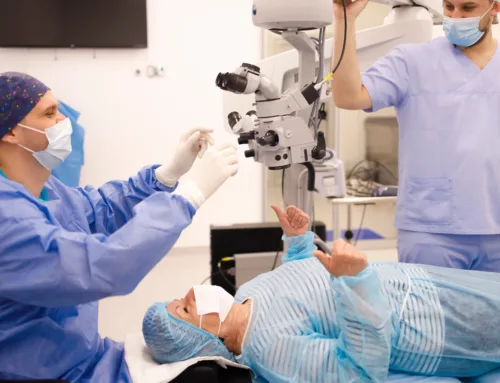Cataract surgery is the most common surgery in the United States. That’s about 4 million cataract surgeries every year in the United States, and many more millions worldwide. Every patient in the United States gets a lens implant and there are many lens options for cataract surgery. This has been the case in developed countries for many years.
Many patients don’t realize (prior to meeting with their surgeon) that they have a choice for which type of lens implant they get.
Modern lens implants are customized to each patient’s eye, allow most to achieve vision free from glasses. Because the eye stops growing, typically long before adults develop cataracts, this glasses-free vision typically remains for the rest of your life.
In this article we’ll discuss everything you need to know about lens options with cataract surgery… Let’s get started!
What are the lens options with cataract surgery available today?
There are a few different categories of lens implants for patients to choose from. This include:
- Monofocal implants
- Multifocal lens implants
- Extended depth of focus implants
- Toric implants
- Light adjustable lens implants
Several of these categories overlap, which can make things appear complicated at first glance. For example, monofocal lens implants come in both toric and non-toric options. We’ll discuss each of these in more detail in the next few sections.
But first… there’s something important to point out before you get too focused on the details of the technical aspects of the lens implant.
Many leading surgeons recommend that patients do not concern themselves with the brand or model of the lens implant.
Instead, they recommend that you focus on how you’d like your vision to look after surgery from the options that are available. These options include:
- Having the best vision in both eyes for distance vision
- Having the best vision in both eyes for near vision
- Having one eye set for distance and the other for near (also known as “monovision” or “blended vision”)
- Multifocal vision or extended depth of focus vision
For more information about each of these vision options, read our “Cataracts 101” article that reviews basics such as “what are cataracts” and these different vision options. This patient education video about cataract surgery also reviews these vision options.
But next, let’s discuss these different categories of lens implants.

Monofocal lens implants
Monofocal lens implants have one focal point. This means that light entering the eye is focused on the retina for one working distance. This working distance can be customized. Some patients may prefer to have clear distance vision without glasses, while other patients may prefer to have better reading vision without glasses.
However, the important thing to note here is that you can only pick one. You can’t have both in the same eye with a monofocal lens implant.
Some patients elect to keep each eye equal to each other so the two eyes work together, giving the best depth perception.
For example, a patient could choose for each eye to have clear distance vision. This would give excellent vision for driving or outdoor activities requiring excellent depth perception, like tennis. However, this patient would require reading glasses for near range activities.
Monofocal lenses can be mixed and matched between a patient’s two eyes. For example, a patient may choose to have a monofocal lens for distance vision implanted in one eye, and a monofocal lens for near vision in the other. Many patients live like this for years with contact lenses or after LASIK. Having the eyes set in this way with lens implants is called monovision, or blended vision, and is very common.
These are lenses that have been designed to ensure that you get the best vision at once, and they are ideal for people who need to see items that are at a distance. For example, if you use reading glasses for near vision tasks, you need this type of lens so that you do not have to get prescription glasses after the surgery.
Multifocal Lens Implants
Multifocal lens implants have multiple focal points. These lenses allow patients to see objects that are both far and near with each eye. These lenses use advanced optics to split the light entering the eye, commonly using a principle called “diffraction”.
By splitting light waves in a controlled way, these lens implants are able to achieve excellent vision without glasses for both distance and near vision in each eye.
Some of these lenses act as bifocals to give better intermediate-range vision, while others give better near vision. Intermediate-range vision can be thought of as the computer screen range or dashboard in the car, while “near vision” refers to reading a book or magazine.
Multifocal lens implants can come with trade-offs. Some patients notice bothersome glare and halo symptoms around bright lights, such as while driving at night, or a loss of contrast. Many times these patients can be identified ahead of time, but not always, and patients should know that there is some risk that they will have bothersome glare, halo, or starburst symptoms after having one of these lens implants. These known side effects are not considered to be cataract surgery complications. Many times, these glare and halo symptoms can go away with time.
Certain patients may not be good candidates for multifocal IOL’s, such as patients with macular degeneration, advanced glaucoma with cataracts, or patients with poorly controlled diabetes and cataracts.
For a more detailed and personalized discussion of multifocal lens implants, please consult with an experienced surgeon.
Extended Depth Of Focus (EDOF) Implants

“Extended Depth of Focus” implants are similar to Multifocal Implants in that their goal is to provide each eye with both distance and some amount of near or intermediate range vision. However, instead of giving two or three discrete focal points, in which focal distances in between can be blurry, these lenses are intended to give a broader range of clear vision.
Consider the example of a bifocal multifocal lens implant like the ZMB00 made by Johnson & Johnson. The ZMB00 is intended to give excellent distance vision, and excellent near vision at approximately 33cm.
What happens if a patient is looking at a computer screen that is 50-60 cm from their eye? Or the dashboard in their car?
For these intermediate ranges, patients may note that the computer screen or dashboard is blurry.
The goal of an EDOF lens is to create a continuous range of clear vision, instead of these discrete clear points with blur in the middle.
While EDOF lenses have been revolutionary, they are not perfect and can come with similar glare, halos, poor contrast vision, or reduced quality of vision symptoms similar to multifocal implants.
Examples of EDOF lens implants are the Vivity IOL and Symfony IOL.
To complicate things further, some lenses use hybrid technologies, such as the Synergy IOL which combines diffractive optics with EDOF technology. The Eyhance IOL has been shown to give an extended depth of focus, however, it is technically classified as a monofocal, or what can be called an “enhanced monofocal”. Similarly, the RayOne EMV provides an extended depth of focus but is also technically classified by the FDA as a monofocal. While Eyhance and RayOne EMV provide extended depth, their classification has to do with the way their clinical trials were conducted and the technical aspects of their approval by the FDA.
For a full discussion on these amazing lens implants, and if they are equitable for you, please discuss them with your surgeon.
Toric Lens Implants
Toric lens implants are designed to correct astigmatism. Management of astigmatism is necessary for every patient interested in having some amount of reduced dependence on glasses after their surgery.
Astigmatism can be corrected in a variety of ways during cataract surgery… but the first step is always measuring how much corneal astigmatism there is.
Many patients commonly think that if they’ve never been diagnosed with astigmatism prior to cataract surgery that they won’t need to have it managed during their cataract surgery.
This is incorrect!
Prior to cataract surgery, the astigmatism of the eye is a combination of astigmatism in the cornea, and astigmatism in the natural lens. These two natural lenses of the eye often can balance each other out to result in a lifetime of not needing astigmatism correction in glasses or contact lenses prior to your cataract surgery.
However, after your cataract is removed, any of this counterbalancing astigmatism in the natural lens is removed.
At this point, all that you’re left with is the astigmatism in your cornea.
For this reason, your surgeon will take measurements on the shape of your cornea, because this will determine how to treat it at the time of surgery.
One option for treating your astigmatism is a toric lens implant, which has astigmatism correction built into the lens implant.
Most monofocal, multifocal, and EDOF lens implants come in toric and non-toric versions.
Light Adjustable Lens Implant
The Light Adjustable Lens Implant is a monofocal lens implant that can be adjusted after it’s already inside your eye. This adjustability allows it to be more accurate in achieving glasses-free vision for many patients.
There are some patients who are particularly difficult to hit the bullseye with traditional, non-adjustable lens implants. These patients include those with extremely long or short eyes, irregular corneal astigmatism, a history of laser vision correction or radial keratotomy, or corneal ectasia.
In these difficult patients, the light adjustable lens is an excellent option to achieve glasses-free vision.
The light adjustable lens comes with some trade-offs, mostly in the form of responsibilities for the patient after surgery.
Patients are required to have multiple additional visits with dilation of the eyes for the adjustment of the lens implant, and after the lens has been fully adjusted, additional visits are required to lock it in. During this adjustment period, which is typically 6-8 weeks after surgery, protective glasses must be worn at all times while awake so that light from the environment does not adjust the lens in an uncontrolled way.
What lens options in cataract surgery are best for me?
Now that we’ve discussed the different lens options that are available in cataract surgery, you’re probably trying to decide which is best for you.
There are many different brands and models of lens implants, and there are different techniques for the surgery, such as cataract surgery with laser assistance.
The most important thing to consider is how you’d like your vision to look after surgery, and have a discussion with your surgeon about your vision goals, lifestyle, and vision needs.
An active golfer or tennis player who still works as an attorney or accountant will have very different vision needs than a less active 95-year-old who doesn’t drive at nighttime any longer.
Having a personalized discussion with your surgeon is the best way to achieve the customized outcome that will be best for you. If you need to find a cataract surgeon in your area search our doctor finder here











